United New Jersey Railroad and Canal Company
|
| |
| Locale | New Jersey and Pennsylvania |
|---|---|
| Dates of operation | 1832–1976 |
| Successor | Amtrak, Conrail |
| Track gauge | 4 ft 8 1⁄2 in (1,435 mm) standard gauge |

The United New Jersey Railroad and Canal Company was a railroad company. It became a subsidiary part of the Pennsylvania Railroad (PRR) system in New Jersey by the merger and acquisition of several predecessor companies in 1872; which purchases also included the PRR's main line to New York City (now Amtrak's Northeast Corridor). Prior to 1872, its main lines were the Camden and Amboy Rail Road and Transportation Company (C&A, below), the first railroad in New Jersey and one of the first railroad in the United States.
The Camden and Amboy was the first railroad to be conceived primarily as a passenger railroad and the first to employ steam locomotives to replace animal powered vehicles on rails. C&A first purchased and operated (what is now the oldest surviving operable steam locomotive in the world today) the John Bull, imported from Great Britain ca. 1832. Its operations also lead to the important development of the iron T-rail type rail tracks that became standard around the world. The United Company also included the Delaware and Raritan Canal, an early foe and then friend of the C&A.
The new conglomerate also included the New Jersey Rail Road and Transportation Company, the first railroad across the New Jersey Palisades.
History

The first railroad charter in the United States was issued February 6, 1815 to the New Jersey Railroad Company on behalf of John Stevens and others. Based on turnpike charters, it allowed the company to build between New Brunswick and Trenton, and became a model for railroad charters in the future.
Camden and Amboy: 1830-1834
The Camden and Amboy Rail Road and Transportation Company (C&A) was chartered on February 4, 1830, on the same day as the Delaware and Raritan Canal Company, after the two competing companies had come to a compromise.[1]:16ff The C&A and D&R had the same goals — to connect the Delaware River, serving Philadelphia, with the Raritan River, for access to New York City — one by tried and true tow-path canal with some new innovations to cross the hills and the other by the novel & as yet untried railroad technology then emerging in Europe. Both ventures were considered risky, and both needed right-of-way grants from the legislature along the river's banks, requiring negotiations and design compromises before either could lay claim to a land rights charter.
Subsequently, the D&R was built to the west of the original C&A, leaving the Delaware at Trenton and running roughly northeast to New Brunswick along the Raritan River valley, while (from the other direction) the original C&A ran south from New York Harbor via South Amboy on Raritan Bay to Camden, thence across the breadth of New Jersey, connecting by ferry across the Delaware River to Philadelphia, both indirectly but much more rapidly linking New York and Philadelphia—at the time America's fastest growing city with its largest city and perhaps more importantly tying together many of its oldest industrial centers.
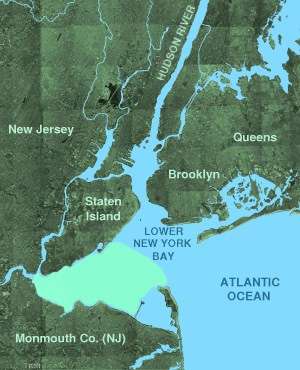
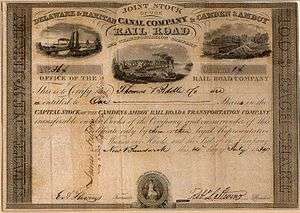
Robert L. Stevens was president of the C&A in the 1830s and 1840s. The C&A was organized on April 28, 1830, and surveys began June 16. As railroads were a relatively new invention, rails and locomotives were bought from England. Construction began December 4, 1830 at Bordentown on the Delaware River; construction efforts were largely carried out by horse-drawn carriages. The John Bull arrived at Bordentown on September 4, 1831 and was first tested November 12. The first section, from Stewarts Point Wharf near Bordentown north to Hightstown, was opened to the public on October 1, 1832, being operated by horse at first. Initially, service between Philadelphia and Stewarts Point Wharf was provided by steamboats, and a stagecoach trip was used between Hightstown and South Amboy. The trip cost $3 and ran in 9.5 hours, 1–2 hours faster than other routes. The rest of the line to South Amboy, the modern day Hightstown Industrial Track, opened December 17, allowing for the elimination of the stagecoach transfer, but the Delaware soon froze on December 27, requiring stagecoach operation south of Bordentown. Freight service began January 24, 1833. Regular locomotive operation by the John Bull began September 9 of that year. Within two months a derailment killed two people; the earliest recorded train accident involving the death of passengers. In Fall 1833 the line was extended south to Delanco, and the full line to Camden was completed December 19, 1834.
Jersey City-Trenton: 1832-1839
On March 7, 1832 the New Jersey Rail Road and Transportation Company (NJRR) was chartered as a parallel line to the C&A, beginning at Jersey City, closer to New York City, but was limited to building south to New Brunswick due to the C&A's influence; the C&A would build the part from New Brunswick south to Spotswood (changed to Trenton in 1836 due to the alliance with the Philadelphia and Trenton Railroad).
In November 1832 the NJRR acquired control of the Newark Turnpike, which paralleled the planned alignment east of Newark, to avoid problems caused by competition. The stock of the Essex and Middlesex Turnpike, running south from Newark to New Brunswick, was bought April 6, 1833; the majority of the line was built directly along the turnpike. The alignment as originally planned crossed the Passaic River on the Centre Street Bridge, then curved south along Park Place and Broad Street directly into the turnpike. A branch would have run from the west end of the bridge south along the river and then southwest to the main line at the south end of Broad Street, but this became the main line and the original plan along Broad Street was never built.
On November 24, 1833 the NJRR bought out the Proprietors of the Bridges over the Rivers Passaic and Hackensack, who had monopolies on their bridges over the Passaic and Hackensack Rivers (on the Newark Turnpike), in order to eliminate their threat. Around 1852, the NJRR acquired the Newark Plank Road and Ferry Company (incorporated 1849) to keep the Passaic and Hackensack monopoly.
Regular NJRR service began September 15, 1834 between Newark and Jersey City, using a temporary track over Bergen Hill. An extension to Elizabeth opened December 21, 1835, using the turnpike from the south end of Broad Street. Service to Rahway began January 1, 1836, again along the turnpike from a point south of Elizabeth. Locomotives were only used south of Newark until January 11, though some horse power operations continued east of Newark. The line opened to east of New Brunswick July 11, with an omnibus transfer the rest of the way; the turnpike was used north of Iselin. On September 8, 1836 the NJRR acquired a majority of stock of the New Brunswick Bridge Company to avoid its local monopoly over crossings of the Raritan River. The double-deck bridge over the Raritan opened October 31, 1837, with a road beneath the railroad, taking the NJRR to New Brunswick. The New Brunswick Bridge Company was authorized to charge a toll on the lower level on May 7, 1838. The old 1795 Albany Street Bridge was removed in 1849, but was later rebuilt.
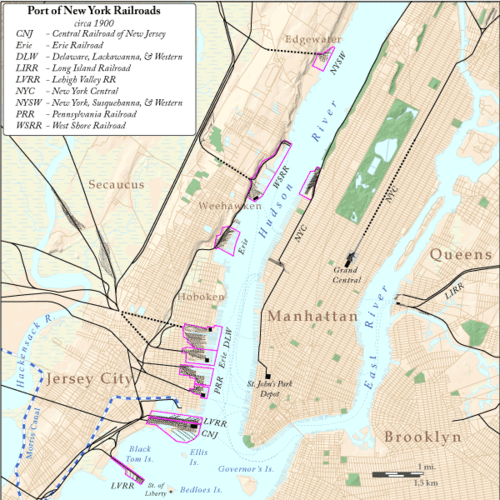
The Bergen Hill Cut, the last part of the Jersey City-New Brunswick line to be finished, opened January 22, 1838, replacing the old temporary alignment over the hill and ending the use of horse power. On March 15, 1837 a supplement to the C&A's charter was passed, allowing the branch to New Brunswick connecting with the New Jersey Rail Road to branch off of the C&A at Bordentown rather than Spotswood, to pass through Trenton for a connection with the Trenton Delaware Bridge and the Philadelphia & Trenton Railroad. Portions could be built next to the Delaware and Raritan Canal or along the New Brunswick and Trenton Turnpike.
Construction on the branch began in September 1837 between Bordentown and Trenton, where it was built on the east bank of the D&R Canal. The initial branch opened April 4, 1838. Construction on the extension to New Brunswick began June of that year, opening January 1, 1839. The branch continued northeast from Trenton on the east bank of the canal, splitting at Kingston and running cross-country to Millstone Junction, southwest of New Brunswick. That same day, the NJRR was completed from New Brunswick to Millstone Junction. Despite forming one third of the route, the NJRR only got one sixth of the earnings from the joint operation, which ran between Philadelphia and New York City in 5.5 hours.
Further connections and realignments: 1839-1867
By 1841, a connection opened between the Philadelphia & Trenton Railroad and the C&A's Trenton Branch, including a bridge over the Delaware and Raritan (D&R) Canal in Trenton; this allowed for through Philadelphia-Jersey City operation, but most traffic continued to run via Camden due to the distance between the P&T's Kensington terminal and Philadelphia.
On May 31, 1854 the C&A decided to realign the Trenton Branch between Trenton and Deans Pond due to bad soil conditions on the current line on the bank of the D&R Canal; a plank road would be built to connect to Princeton, which the new alignment would bypass. A tunnel under the canal in Trenton was completed in March 1860 (for the line between the Philadelphia and Trenton Railroad and the new alignment). Construction on the new line began October 1862; the Clinton Street Station on the new line at Trenton opened April 20, 1863, replacing the old State Street Station. The first train ran through the new tunnel on October 5, 1863, and the new line opened November 23, cutting New York City-Trenton time to 2.5 hours. The second track on the new line opened September 1864, but the old line remained for southbound freight. The Princeton Branch opened May 29, 1865, on which date passenger trains stopped running over the old line. The old line was removed between Trenton and Princeton in July; a portion in Trenton was kept to serve businesses. The Princeton-Kingston section was removed in September on the start of freight operations on the Princeton Branch; track north of Kingston (which was not next to the canal) was retained to serve the Rocky Hill Railroad.
.jpg)
Closely tied to the early NJRR was the Paterson and Hudson River Railroad (P&HR), later the main line of the Erie Railroad. The P&HR agreed in June 1833 to build to the west side of the New Jersey Palisades at Marion Junction, where it would use the NJRR's Bergen Hill Cut the rest of the way to the Hudson River. The P&HR opened November 29, 1833, prior to the opening of any part of the NJRR, in the meantime using a stagecoach along the Newark Turnpike to reach the river. A trackage rights agreement was made October 10, 1834, and P&HR operation to Jersey City began October 20. The Long Dock Tunnel opened April 15, 1861, giving the P&HR (by then part of the Erie) its own route to the Hudson River.
Also involved with the NJRR was the Morris and Essex Railroad (M&E), later the Delaware, Lackawanna and Western Railroad's (DL&W) main line. On October 21, 1836 the NJRR agreed to carry M&E traffic between Newark and Jersey City, beginning November 19. A new alignment meeting the NJRR in Harrison opened August 5, 1854. On October 14, 1863, the M&E began using the Long Dock Tunnel.
The Central Railroad of New Jersey (CNJ) also used the NJRR to reach Jersey City from Elizabeth until its own line opened on August 1, 1864.
The C&A often used legislative and legal means to protect its monopoly on New York City-Philadelphia travel. The monopoly was finally broken on May 1, 1876, with the completion of the National Railway, over seven years after the legal monopoly expired.
On January 19, 1831 New Jersey passed a supplement to the D&R Canal's charter, allowing them to build a railroad alongside their canal. However, this was soon mooted by the union between the C&A and D&R. On February 15, 1831, the C&A and D&R were combined as the Joint Companies, with all important decisions made by a Joint Board, and all stock was consolidated.
An act passed February 4, 1831 gave the C&A monopoly powers for nine years against railroads built within three miles of the C&A, in exchange for the state receiving 1000 shares of stock. The Protection Act, passed March 2, 1832, expanded this to give the Joint Companies a monopoly on New York City-Philadelphia traffic across New Jersey. On March 16, 1854 this exclusive right was extended to January 1, 1869, as long as the C&A helped other railroads including the West Jersey Railroad and double-tracked its main line.
In Summer 1835 Robert F. Stockton bought control of the Trenton Delaware Bridge and Philadelphia and Trenton Railroad to end its competition with the C&A and the legal battle to connect at New Brunswick with the NJRR. On October 12 the C&A/D&R Joint Board authorized a purchase of the P&T, and an agreement was signed November 11, by which the P&T would send all traffic beyond Trenton to New York City via the C&A. A pro-C&A board was elected by the P&T on January 12, 1836, and on June 1 the stock of all three companies was divided pro rata.
On September 1, 1862, a competing line began operating via the Raritan and Delaware Bay Railroad and Camden and Atlantic Railroad, running steamboats between New York City and Port Monmouth at the north end of the R&DB. This common threat caused the C&A and NJRR to work more closely, signing an agreement October 1. The Newark and New York Railroad, later part of the Central Railroad of New Jersey, opened in July 1869, giving major competition to the NJRR from Newark east.
PRR lease
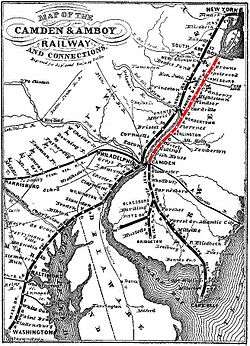
On February 1, 1867, the C&A and NJRR were informally joined as the United New Jersey Railroad and Canal Companies (UNJ). The Pennsylvania Railroad (PRR) approved a lease of the UNJ on May 15, 1871, and the UNJ approved May 19. On May 18, 1872 the C&A, D&R Canal and NJRR were consolidated, forming the United New Jersey Railroad and Canal Company. The new company was split into two divisions: the New York Division consisted of the NJRR and the C&A Trenton Branch towards Philadelphia, while the Amboy Division was the original C&A main line.
In 1968 the PRR merged with the New York Central Railroad, to form the Penn Central. A series of events including inflation, poor management, abnormally harsh weather conditions and the withdrawal of a government-guaranteed 200-million-dollar operating loan forced the Penn Central to file for bankruptcy protection in 1970.[1]:233–234 The Penn Central operated under court supervision until 1976, when the Northeast Corridor rail line was transferred to Amtrak for use in passenger service, and the remaining lines were transferred to Conrail.[2]:4–5 Initially Conrail operated commuter rail service on its lines under contract to the New Jersey Department of Transportation. In 1979, the commuter lines were acquired by New Jersey Transit.[2]:20
Other branches
- Burlington and Mount Holly Railroad and Transportation Company - opened in 1849, providing a branch from Burlington southeast to Mount Holly. From opening it was controlled by the C&A.
- Belvidere Delaware Railroad - also controlled by the C&A, opened in stages from 1851 to 1855, running north from Trenton to Belvidere. The BDRR was leased to the UNJ on January 1, 1876.
- Freehold and Jamesburg Agricultural Railroad - opened in 1853 from the C&A at Jamesburg east to Freehold, also under C&A control. In January 1866 a connecting line opened between the new Trenton Branch at Monmouth Junction and the original main line at Jamesburg. That line, built under the F&J charter, was transferred to the United New Jersey Railroad and Canal Company on July 29, 1874. A July 16, 1879 agreement leased the F&J to the UNJ from June 1, 1879.
- Millstone and New Brunswick Railroad - opened in 1854, running west from the south end of the NJRR at Millstone Junction to Millstone. The M&NB was bought on April 21, 1915 at foreclosure.
- Bonhampton - opened in 1860
- Perth Amboy and Woodbridge Railroad, operated by the NJRR, opened in 1864 as a branch from Rahway south to Perth Amboy. A June 26, 1889 agreement leased the PA&W to the UNJ from January 1, 1891.
- Rocky Hill Railroad and Transportation Company - opened in 1864 as a branch of the C&A from Kingston on the old alignment north to Rocky Hill. The C&A leased it November 22, 1869 and began operating it June 1, 1870.
- Camden and Burlington County Railroad - running east from Camden to Mount Holly, opened in 1867 under C&A operation. In 1868 the C&A leased the Vincentown Branch of Burlington County Railroad, and soon after formally leased the C&BC.
- Pemberton and Hightstown Railroad - opened from the C&A at Hightstown south to Pemberton in 1868, under lease and operation by the C&A.
- NJRR was authorized to acquire underwater land at Harsimus Cove on March 30, 1868. That land became a major freight terminal, served by the Harsimus Branch.
- Mount Holly, Lumberton and Medford Railroad opened in 1869 under C&A lease, running south from Mount Holly to Medford.
- In April 1870 a new direct line opened across the Passaic River, bypassing the Centre Street Bridge. The old bridge remained for freight and to serve downtown. Included in the new line was a new station at Market Street, now Newark Penn Station.
- Columbus, Kinkora and Springfield Railroad - leased March 11, 1871. The Mercer and Somerset Railroad was leased October 1, 1871.
- In 1872 a short branch was built at Florence to serve a foundry on the Delaware River.
- Millham Branch - opened in 1876, connected the old and new alignments northeast of Trenton.
Current
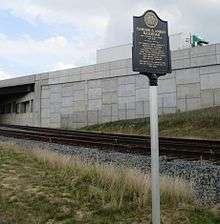
Until 1999, the original C&A alignment and the Trenton Branch from Pavonia Yard to Trenton was labeled as Conrail's Bordentown Secondary. It is presently operating as New Jersey Transit's RiverLINE, a Diesel multiple unit light rail transit system. Freight trains operate overnight under a Federal Railroad Administration waiver. The remaining portion of the Trenton Branch is part of Amtrak's Northeast Corridor.
The original line from Bordentown heading north to Robbinsville is operated by CSX as the Robbinsville Industrial Track. The line ceased being a through route in 1967 when the PRR severed trackage between Windsor-Hightstown. Conrail abandoned the Hightstown-Cranbury segment in late 1982; additional trackage between Windsor-Robbinsville was dismantled in 2011 by Conrail Shared Assets. CSX operates the line north of Cranbury to South Amboy via Jamesburg.
The Princeton Branch is still used by New Jersey Transit for passengers. The old alignment in Trenton is still used for freight; the old alignment from Rocky Hill to Monmouth Junction was abandoned in 1983 by Conrail, and the Rocky Hill Branch was obliterated by Conrail for the use of a rail trail along the D&R Canal. However, the Florence Branch still exists.
For 49 miles east from Trenton to the site of Manhattan Transfer station the line is part of the Northeast Corridor; from there east to the east side of the Palisades PATH and Conrail's Passaic and Harsimus Line occupy the right-of-way, side by side. East of the Palisades, the elevated structure to Exchange Place Terminal has been largely torn down, as has the elevated structure to Harsimus Cove (with the exception of the Harsimus Stem Embankment),[3] but PATH follows the alignment of the former underground.
See also
References
- 1 2 Stover, John F. (1997). American Railroads (2nd ed.). Chicago: University of Chicago Press. ISBN 978-0-226-77658-3.
- 1 2 United States Railway Association (USRA), Washington, DC. "The Conveyance Process: A Supplement to the Final Report of the United States Railway Association." December 1986.
- ↑ Embankment Preservation Coalition, Jersey City, NJ. "The Harismus Stem Embankment." Accessed 2011-02-19.
External links
- History of the Camden & Amboy
- Camden & Amboy Railroad: Two Original “Joint Stock” Certificates Signed by Robert L. Stevens, Inventor of the "T"-Rail and Railroad Spike.
| Preceded by |
The Camden and Amboy Rail Road and Transportation Company chartered February 4, 1830 merged May 18, 1872 |
Succeeded by The United New Jersey Railroad and Canal Company |
| Preceded by |
The New Jersey Rail Road and Transportation Company chartered May 7, 1832 merged May 18, 1872 |
Succeeded by The United New Jersey Railroad and Canal Company |